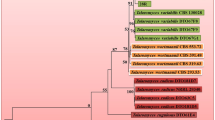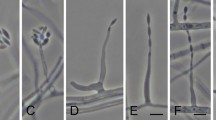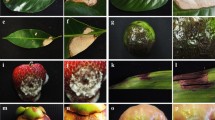Abstract
THE physiology of vascular wilt diseases caused by Fusarium and Verticillium species has received considerable attention during recent years1–4. Of these organisms, less work has been carried out on Verticillium, and certain aspects of the disease syndrome caused by this fungus are not fully understood. Studies on symptom initiation have for the most part been concerned with the production by the fungus of pectolytic enzymes5–11. Numerous authors have mentioned the possible role of toxins in disease initiation, but little supporting experimental evidence has so far been produced. Moreover, from the lack of a precise definition, the toxins of some authors12,13 might include extracellular pectolytic enzymes. Porter and Green14 and Green15 published the first authentic accounts of toxins produced in Verticillium culture filtrates. Bio-assay of nearly all suspected disease-inducing agencies has been on cut shoots, in an attempt to simulate wilt conditions, in the naturally infected plant. In Nature, however, wilting symptoms usually develop after about 14 days, and experiments in this laboratory have shown that, in the case of seedling infection, growth inhibition rather than overall wilting is a more valid symptom of disease. Up to five weeks after infection in these plants wilting is a gradual basipetal desiccation while the leaf area of apparently turgid leaves is reduced by 80 per cent. This symptom is quite different from the general collapse of turgor common in mature infected plants and may be independent of it.
This is a preview of subscription content, access via your institution
Access options
Subscribe to this journal
Receive 51 print issues and online access
$199.00 per year
only $3.90 per issue
Buy this article
- Purchase on Springer Link
- Instant access to full article PDF
Prices may be subject to local taxes which are calculated during checkout
Similar content being viewed by others
References
Dimond, A. E., Ann. Rev. Plant Physiol., 6, 329 (1955).
Dimond, A. E., Trans. N.Y. Acad. Sci., Ser. II, 27, 609 (1959).
Sadasivan, T. S., Ann. Rev. Plant Physiol., 12, 449 (1961).
Wood, R. K. S., Ann. Rev. Plant Physiol., 11, 299 (1960).
Kamal, M., and Wood, R. K. S., Nature, 175, 264 (1955).
Scheffer, R. P., Gothoskar, S. S., Pierson, C. F., and Collins, R. P., Phytopath., 46, 83 (1956).
Leal, J. A., and Villanueva, J. R., Microbiol. Espanola, 15 (3), 199 (1961).
Wood, R. K. S., Ann. App. Biol., 49, 120 (1961).
Blackhurst, F. M., and Wood, R. K. S., Ann. App. Biol., 52, 89 (1963).
Deese, D. C., and Stahmann, M. A., Phytopath. Z., 46, 1, 53 (1962).
Matta, A., Phytopath. Medit., 2, 55 (1963).
Weir, G. M., Mycopath. Mycol. Appl., 18 (3), 194 (1962).
McLeod, A. G., and Smith, H. P., N.Z. J. Agric. Res., 4, 123 (1961).
Porter, G. L., and Green, R. J., Phytopath., 42, 472 (1952).
Green, R. J., Phytopath., 44 (8), 433 (1954).
Pegg, G. F., Ann. Bot. N.S., 26, 207 (1962).
Author information
Authors and Affiliations
Rights and permissions
About this article
Cite this article
PEGG, G. Phytotoxin Production by Verticillium albo-atrum Reinke et Berthold. Nature 208, 1228–1229 (1965). https://doi.org/10.1038/2081228b0
Issue Date:
DOI: https://doi.org/10.1038/2081228b0
This article is cited by
-
Karyotypic variability in plants of Solanum melongena regenerated from callus grown in presence of culture filtrate of Verticillium dahliae
Theoretical and Applied Genetics (1984)
Comments
By submitting a comment you agree to abide by our Terms and Community Guidelines. If you find something abusive or that does not comply with our terms or guidelines please flag it as inappropriate.



